
- Home
- Travel Packages
- Top Destination
-
Travel Attraction
By Category
Top Attraction
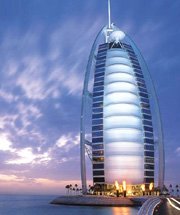
- Travel Agents
- Car Rentals
- Hotels
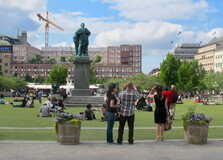
Kungsträdgården, which translates to “The King’s Garden,” is one of the most central and well-known parks in Stockholm, Sweden. Located in the heart of the city, this urban green space is not only a popular meeting point but also a hub for cultural events, concerts, art exhibitions, seasonal markets, and festivals. The park is surrounded by shops, cafes, museums, and historic buildings, making it a lively destination year-round. Known for its iconic cherry blossoms in spring and open-air ice rink in winter, Kungsträdgården is a must-visit spot for locals and tourists alike. How to Reach Kungsträdgården, Stockholm Kungsträdgården is easily accessible from all parts of Stockholm due to its central location in Norrmalm, the downtown area. By Metro: Take the blue line (T10 or T11) and get off at the "Kungsträdgården" metro station, which is located right under the park. By Bus: Several buses stop nearby, including routes 2, 55, and 65. The park is just a short walk from the stops. By Tram: Tram line 7 stops near Kungsträdgården, especially if you're coming from Djurgården. By Foot: Kungsträdgården is within walking distance from major sites like the Royal Palace, Sergels Torg, and Gamla Stan. By Bicycle: Stockholm is a very bike-friendly city. You can cycle to the park using dedicated bike lanes. Weather in Stockholm Weather in Stockholm affects the activities available at Kungsträdgården, and each season offers a different experience: Spring (March–May): Mild temperatures (5°C to 15°C). April is especially popular when the cherry blossoms bloom, drawing large crowds to the park. Summer (June–August): Warm and sunny (18°C to 25°C). Ideal for open-air concerts, cafes, and walking tours. Autumn (September–November): Cooler (5°C to 15°C), with beautiful foliage. A peaceful time to visit and enjoy the changing colors. Winter (December–February): Cold and often snowy (0°C to -7°C). The park transforms into a winter wonderland with an ice skating rink and festive lights. Timings for Kungsträdgården, Stockholm Kungsträdgården is an open public park and accessible 24 hours a day, all year round. However, the availability of specific events, cafes, and attractions such as the ice rink or live performances may vary by time and season. Most restaurants and kiosks in the area operate from around 10:00 AM to 10:00 PM. Why is Kungsträdgården Famous? Kungsträdgården is famous for being a cultural and social hotspot in the city of Stockholm. Here's what makes it so special: Cherry Blossoms: The cherry trees bloom beautifully in April, making the park a favorite spot for photography and picnics. Cultural Events: The park hosts concerts, food festivals, art installations, and public events throughout the year. Historic Significance: Originally a royal garden, it has been a part of Stockholm’s history for centuries. Winter Activities: During winter, the park features a free ice skating rink, festive decorations, and cozy holiday markets. Central Location: It is surrounded by some of the city’s most notable landmarks, making it a perfect stop during sightseeing. Entry and Visit Details about Kungsträdgården, Stockholm As a public park, entry to Kungsträdgården is completely free. There are no admission fees, and you can explore the area at your leisure. Events, pop-up exhibitions, and performances may be ticketed, but many are free of charge. The ice skating rink in winter is also free, though you may need to rent skates if you don’t have your own. Public restrooms, benches, drinking fountains, and food stands are available throughout the park. There is also free Wi-Fi in many parts of the city center, including Kungsträdgården. History and Architecture of Kungsträdgården Kungsträdgården has a long and royal history. It dates back to the Middle Ages when it was the king’s private garden. Over time, it was opened to the public and became a place for social gatherings and entertainment. The park features statues of Swedish kings such as Karl XII and Karl XIII, beautiful fountains, tree-lined paths, and remnants of historical architecture. Beneath the park lies the Kungsträdgården Metro Station, known for its artistic underground design and archaeological features. Things to Do at Kungsträdgården, Stockholm Kungsträdgården offers a range of relaxing and engaging activities: Enjoy the Blossoms: Visit in April to witness the cherry trees in full bloom. It’s one of the most Instagram-worthy scenes in Stockholm. Ice Skating: Lace up your skates and hit the outdoor rink during winter. It's lit up in the evenings and perfect for families and couples. Attend a Concert or Festival: Music, dance, and food festivals are held regularly during summer. Explore Public Art: View statues, fountains, and seasonal installations scattered throughout the park. Grab a Coffee: Visit nearby cafes or food kiosks and enjoy a Swedish fika in the open air. People-Watching: Take a seat on one of the many benches and watch the city life flow by—locals walking dogs, street musicians, and children playing. Nearby Attractions: Visit the nearby Royal Swedish Opera, Gallerian shopping mall, and Gamla Stan (Old Town), all within walking distance. Facts and Tips about Kungsträdgården, Stockholm No Admission Fee: The park is completely free to enter, making it ideal for budget travelers. Pet-Friendly: Dogs are allowed, but they should be kept on a leash. Best Time to Visit: Spring for the cherry blossoms or December for the winter skating experience. Photography Tip: Visit early in the morning to catch the soft light and avoid the crowds during cherry blossom season. Public Transportation: Easily reachable via metro, tram, and buses—no need for a car. Restrooms and Cafes: Public toilets are available, and there are plenty of dining options around. Accessibility: The park is wheelchair accessible and has smooth paths for easy mobility. Conclusion Kungsträdgården is much more than just a city park—it's a lively cultural center, a peaceful escape in the middle of a bustling city, and a historical landmark with royal roots. Whether you're visiting Stockholm in spring to see the cherry blossoms or in winter to enjoy ice skating, Kungsträdgården offers a year-round destination filled with beauty and activity. It reflects the heart of the city—welcoming, vibrant, and always alive with something happening. No trip to Stockholm is complete without spending some time in the King’s Garden.
Explore More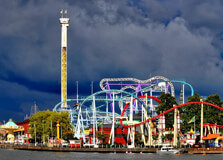
Gröna Lund is Stockholm’s iconic amusement park, located on the island of Djurgården. Founded in 1883, it is the oldest amusement park in Sweden and one of the most beloved family attractions in the country. Gröna Lund blends old-world charm with modern-day thrills, offering roller coasters, games, concerts, and entertainment for all ages. Its location by the waterfront provides stunning views and a unique atmosphere that combines fun, nostalgia, and excitement. Whether you’re a thrill-seeker, a music lover, or just looking for a good time with friends and family, Gröna Lund is a must-visit during the summer months in Stockholm. How to Reach Gröna Lund, Stockholm Gröna Lund is centrally located on Djurgården and is easy to access via various modes of transport: By Tram: Take tram line 7 from the city center and get off at the “Gröna Lund” stop. The entrance is just a few steps away. By Bus: Bus line 67 stops at Djurgården, a short walk from the park. By Ferry: From Slussen or Nybroplan, you can take a ferry to Allmänna gränd, which is right next to the park entrance. By Walking or Cycling: Djurgården is a popular area for pedestrians and cyclists. It’s about a 20-minute walk from the city center along beautiful waterfront paths. By Car: While possible, parking is limited. It's more convenient to use public transport during busy months. Weather in Stockholm Gröna Lund is a seasonal outdoor amusement park, and the weather plays a key role in your experience: Spring (April to May): Mild weather with temperatures between 10°C and 18°C. A good time to visit before summer crowds arrive. Summer (June to August): Peak season with temperatures ranging from 18°C to 25°C. Long sunny days make it perfect for enjoying rides and outdoor concerts. Autumn (September to October): Cooler weather (10°C to 15°C) and smaller crowds. The Halloween events are especially popular during this season. Winter (November to March): Gröna Lund is closed for the season during winter and usually reopens in late April or early May. Timings for Gröna Lund, Stockholm Gröna Lund operates seasonally, typically from late April to the end of September, with special openings in October for Halloween events: May to August: Open daily, usually from 11:00 AM to 10:00 PM or later (on concert days). September: Open on select weekends. October: Open for Halloween events with spooky decorations and themed attractions. Opening hours vary depending on the day and events, so it’s best to check the official website for daily schedules. Why is Gröna Lund Famous? Gröna Lund is famous for its rich history, thrilling rides, and vibrant entertainment. Here are some of the reasons it stands out: Historic Amusement Park: It has operated since 1883 and still retains some of its vintage charm alongside modern rides. Waterfront Location: Overlooking Stockholm’s harbor, the setting is unique and picturesque. Concert Venue: Gröna Lund hosts open-air concerts with international artists such as Bob Marley (historically), The Cardigans, and even Metallica. Wide Range of Rides: From kiddie rides to high-adrenaline roller coasters, there's something for everyone. Family-Friendly Events: Seasonal themes like Halloween and fun zones for younger children make it a great family destination. Entry and Visit Details about Gröna Lund, Stockholm Gröna Lund has a unique ticketing system that includes both entrance tickets and ride passes. Prices vary based on age and ticket type: Entrance Only: Around SEK 155–175 Ride Pass (including entrance): Around SEK 395–495 depending on the date and event Children under 2: Free entry Concert Days: Admission is included in the ride pass, but the price may be higher Tickets are best bought online in advance, especially during weekends and concert events. Season passes are also available for frequent visitors. History and Architecture of Gröna Lund Gröna Lund opened in 1883 and is the oldest amusement park in Sweden. It began as a collection of simple fairground attractions and evolved over time into a full-scale theme park. Unlike larger parks that build new structures on open land, Gröna Lund is built in a compact space between historic buildings on Djurgården. This gives the park a very unique and cozy atmosphere, where old meets new. The park preserves parts of its early architecture, such as wooden façades and decorative details, blending them with the colorful, flashy elements of modern amusement rides. Its compact design is cleverly used to stack roller coasters and rides in layered formats, creating a dense and exciting experience. Things to Do at Gröna Lund, Stockholm Gröna Lund is packed with activities and attractions for all age groups: Thrill Rides: Brave roller coasters like “Insane,” “Jetline,” and “Monster,” or enjoy the drop tower “Eclipse.” Family Rides: Fun attractions like the Fun House, bumper cars, and the Ferris wheel offer great experiences for families. Kiddie Rides: Safe and enjoyable rides like mini trains, carousels, and flying elephants are ideal for small children. Games & Arcades: Try your luck at carnival games and win prizes or enjoy classic arcade games. Live Entertainment: From pop concerts and magic shows to acrobatic performances, there’s always something happening on the main stage. Seasonal Events: Halloween is a popular time to visit, with haunted houses and creepy shows throughout the park. Dining: Choose from a wide variety of food stalls, snack bars, and restaurants offering everything from fast food to traditional Swedish dishes. Facts and Tips about Gröna Lund, Stockholm Cashless: Gröna Lund is a cash-free park. Bring a credit or debit card, or use mobile payment. Height Restrictions: Many rides have height limits, so check before queuing, especially if you’re with children. Arrive Early: Popular rides and concerts can get crowded later in the day. Buy Tickets Online: It’s cheaper and faster to book tickets in advance via their website. Concert Tips: Arrive early to get a good spot for evening performances—access is first come, first served. Rain Policy: The park remains open during rain, but some rides may be temporarily closed due to safety precautions. Combo with Other Attractions: Located near Skansen, ABBA Museum, and the Vasa Museum, so plan a full day on Djurgården. Conclusion Gröna Lund is a place where tradition meets fun. With over a century of history, world-class entertainment, and an unbeatable location on the water, it remains a favorite destination for both locals and tourists. Whether you're in Stockholm with family, friends, or on your own, a day at Gröna Lund offers joy, laughter, and memories that last a
Explore More
Mariebergsskogen is a large public park and open-air museum located in Karlstad, Sweden. It is one of the city’s most popular recreational spots, attracting visitors of all ages throughout the year. The park combines natural beauty with cultural heritage, offering scenic walking trails, a beach area by Lake Vänern, a zoo featuring Nordic animals, and historical buildings that reflect Sweden’s rural past. It is an ideal destination for families, nature enthusiasts, and history lovers looking to enjoy both relaxation and educational experiences in one place. How to Reach Mariebergsskogen, Karlstad Mariebergsskogen is conveniently located just a few kilometers from Karlstad city center. You can reach it easily by: By Car: From Karlstad city center, drive along Västra Kanalgatan and follow signs to Mariebergsskogen. Parking is available on-site. By Public Transport: Local buses run regularly from the city center to Mariebergsskogen. The journey takes about 10 minutes. By Bicycle or On Foot: The park is within walking and cycling distance from downtown Karlstad, with dedicated paths for pedestrians and cyclists. Weather in Mariebergsskogen, Karlstad The weather in Karlstad is seasonal, with mild summers and cold winters. During summer (June to August), temperatures range between 15°C and 25°C, making it perfect for outdoor activities. Spring and autumn offer cooler but pleasant conditions for walks and sightseeing. In winter (December to February), temperatures can drop below freezing, and the park often transforms into a snowy wonderland, ideal for winter walks and photography. Timings of Mariebergsskogen Mariebergsskogen is open all year round. While the park itself is accessible 24 hours a day, some attractions within the park, such as the zoo, café, and exhibition areas, have specific opening hours. In summer, these facilities typically operate from morning until late afternoon, while in winter, hours may be shorter. Why Mariebergsskogen is Famous Mariebergsskogen is famous for its unique combination of nature, culture, and family-friendly activities. It houses an open-air museum with historic buildings from different regions of Sweden, a small zoo showcasing Nordic wildlife, and large green spaces for recreation. The park’s location by Lake Vänern also makes it a popular spot for swimming, sunbathing, and picnicking during the warmer months. Seasonal events, concerts, and festivals further add to its charm. Entry and Visit Details Entry to Mariebergsskogen is free, making it a highly accessible attraction for everyone. However, certain activities or exhibitions may require a small fee. Guided tours are sometimes available for groups, offering more insight into the history and features of the park. Facilities such as toilets, cafés, and picnic areas are available to enhance visitor comfort. History and Architecture of Mariebergsskogen Mariebergsskogen was established in the early 20th century when a local businessman, Dr. Conrad Höök, donated the land to the city of Karlstad with the vision of creating a public recreational space. Over the years, it evolved into an open-air museum, showcasing traditional Swedish rural architecture. Many of the buildings, such as farmhouses, barns, and cottages, were relocated from other parts of Sweden to preserve them and give visitors a glimpse of past lifestyles. The park’s layout is thoughtfully designed, blending historical structures with natural landscapes. Things to Do in Mariebergsskogen Explore the open-air museum and its historical buildings. Visit the zoo to see Nordic animals such as moose, reindeer, and goats. Relax on the sandy beach by Lake Vänern during summer. Enjoy scenic walking and cycling trails. Attend cultural events, concerts, and seasonal festivals. Have a picnic in designated areas or dine at the park’s café. Engage in children’s activities and playgrounds for family fun. Facts about Mariebergsskogen Mariebergsskogen covers a large area, making it Karlstad’s largest park. It is home to both cultural heritage buildings and natural habitats. The park is a popular venue for local festivals and music concerts. It offers free entry to the general public. It is located on the shores of Lake Vänern, the largest lake in Sweden. Tips for Visiting Mariebergsskogen Wear comfortable shoes for walking as the park covers a large area. Bring a picnic basket to enjoy a meal outdoors. Check the park’s event schedule before visiting to catch special programs. Visit during summer for swimming and outdoor fun, or in winter for a peaceful snowy experience. If traveling with children, plan extra time for the zoo and playground areas.
Explore More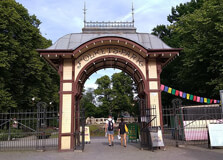
Folkets Park in Malmo is one of Sweden’s oldest public parks and a beloved recreational hub for both locals and visitors. Known for its lush greenery, vibrant atmosphere, and family-friendly entertainment, this park has been a gathering place for over a century. It seamlessly blends cultural heritage with modern activities, offering something for all ages—from playgrounds and cafes to festivals and open-air concerts. Whether you want to relax in a green setting, enjoy amusement rides, or participate in seasonal events, Folkets Park is a must-visit destination in Malmo. How to Reach Folkets Park, Malmo Folkets Park is conveniently located in the heart of Malmo, making it easily accessible by various modes of transportation: By Train: From Malmo Central Station, you can take a short bus ride or a pleasant 20-minute walk to the park. By Bus: Multiple local bus routes, including lines 5, 32, and 35, stop close to Folkets Park. The nearest stops are "Folkets Park" or "Nobelvägen." By Bicycle: Malmo is known for being bike-friendly, and the park has ample bike parking facilities. By Car: If driving, there are parking areas nearby, though spaces can be limited during busy weekends or event days. Weather in Malmo Malmo experiences a temperate oceanic climate, which makes Folkets Park a year-round attraction: Spring (March to May): Mild weather with blooming flowers, perfect for outdoor walks. Summer (June to August): Warm and sunny, with temperatures averaging 20–25°C, ideal for picnics and outdoor activities. Autumn (September to November): Cool and crisp with beautiful foliage, great for photography. Winter (December to February): Cold and sometimes snowy, creating a magical setting for Christmas markets and winter events. Timing Folkets Park is generally open 24 hours a day, as it is a public space. However, certain facilities, cafes, and attractions within the park have their own operating hours, typically from 10:00 AM to 6:00 PM. Event timings may vary, so checking the official website before visiting is recommended. Why Famous for Folkets Park, Malmo? Folkets Park is famous for its historical significance, cultural events, and community-friendly vibe. Established in 1891, it was one of the first public parks in Sweden aimed at providing recreational space for all social classes. Today, it is celebrated for its summer concerts, cultural festivals, open-air theater performances, amusement rides, playgrounds, and cozy picnic areas. Entry and Visit Details Entry to Folkets Park is free, making it accessible to everyone. Some activities, such as amusement rides, mini-golf, or special events, may have separate ticket fees. The park has public toilets, cafes, and designated picnic areas for visitor convenience. History and Architecture The history of Folkets Park dates back to the late 19th century when it was created as a recreational and cultural hub for workers and their families. Over the decades, it evolved into a symbol of social gathering, democracy, and leisure in Sweden. Architecturally, the park blends traditional Swedish landscape design with modern installations. The open-air stages, pavilions, and green lawns have hosted countless community celebrations and concerts over the years. Things to Do Enjoy seasonal events like summer music festivals and winter Christmas markets. Take your children to the large playgrounds and adventure areas. Try mini-golf or amusement rides for a fun family day out. Relax at one of the cafes or have a picnic on the lawns. Attend outdoor theater performances or cultural exhibitions. Stroll around the gardens and enjoy the flowers in bloom during spring. Facts about Folkets Park, Malmo It is considered the oldest public park of its kind in Sweden, founded in 1891. The park hosts over 2 million visitors annually. It serves as a venue for political speeches, cultural events, and family entertainment. The park’s design has been updated over time to include modern recreational facilities while preserving historical features. Tips for Visiting Visit during summer for the liveliest atmosphere and outdoor events. Bring a picnic blanket and enjoy a relaxed afternoon on the lawns. If traveling with kids, check out the schedule for family-friendly events. Wear comfortable shoes, as there is plenty to explore on foot. Check the weather forecast to plan activities accordingly. Arrive early on weekends to avoid crowds, especially during special events.
Explore More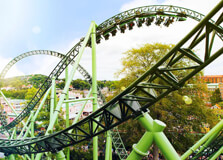
Liseberg Amusement Park in Gothenburg, Sweden, is one of the most famous amusement parks in Europe and a top attraction in Scandinavia. Known for its thrilling rides, beautiful gardens, concerts, and seasonal events, it attracts millions of visitors every year. Whether you are a thrill-seeker looking for adrenaline-pumping roller coasters or a family searching for fun and entertainment, Liseberg offers a perfect blend of excitement and leisure. Established in 1923, it has grown into an iconic destination that combines tradition with modern attractions. How to Reach Liseberg Amusement Park, Gothenburg Liseberg Amusement Park is centrally located in Gothenburg, making it easily accessible by various means of transportation: By Air: Gothenburg Landvetter Airport is the nearest airport, about 20 km from the park. From the airport, you can take an airport bus or taxi to reach Liseberg in approximately 25–30 minutes. By Train: Gothenburg Central Station is well-connected with major cities in Sweden and nearby countries. From the station, tram lines 2, 4, 5, or 13 can take you directly to Liseberg. By Tram or Bus: Local trams and buses stop right outside the park. Tram lines 5 and 8 are the most popular choices. By Car: The park can be reached via E6 or E20 highways, with parking facilities available nearby. Weather at Liseberg Amusement Park, Gothenburg The weather in Gothenburg varies throughout the year, influencing the park’s atmosphere and events: Spring (March–May): Mild temperatures with blooming flowers make it a beautiful time to visit. Summer (June–August): Warm and sunny, perfect for enjoying all outdoor rides and attractions. Autumn (September–November): Cooler weather with seasonal decorations, especially during Halloween events. Winter (December–February): The park transforms into a magical Christmas market with festive lights and winter-themed attractions. Timing of Liseberg Amusement Park, Gothenburg Opening hours vary depending on the season: Summer Season: Typically open from late April to mid-September, from 11:00 AM to late evening (10 PM or later on weekends). Halloween Season: Open during select dates in October and early November. Christmas Season: Open from mid-November to end of December with special hours for festive events. It is always recommended to check the official website before planning your visit for updated schedules. Why Famous for Liseberg Amusement Park, Gothenburg? Liseberg is famous for its thrilling roller coasters like Helix and Balder, family-friendly rides, large green areas, live concerts, and seasonal festivities. It is considered one of the most beautiful amusement parks in the world, thanks to its lush gardens and charming Scandinavian atmosphere. Entry and Visit Details about Liseberg Amusement Park, Gothenburg The park charges an entrance fee, and ride tickets are purchased separately or through an unlimited-ride wristband. Discounts are available for children, seniors, and families. Online booking is recommended during peak seasons to avoid long queues. Security checks are performed at the entrance, and outside food is generally not allowed. History and Architecture of Liseberg Amusement Park, Gothenburg Liseberg opened in 1923 as part of Gothenburg’s 300th-anniversary celebrations. Over the years, it has expanded to include modern roller coasters, performance stages, and themed areas while retaining classic rides. The park’s architecture blends traditional Scandinavian wooden structures with contemporary amusement park designs, creating a unique and charming setting. Things to Do at Liseberg Amusement Park, Gothenburg Ride the Helix: A world-class roller coaster with multiple inversions and twists. Experience Balder: An award-winning wooden roller coaster known for its smooth ride. Family Rides: Carousels, Ferris wheels, and gentle rides for younger visitors. Seasonal Events: Halloween haunted houses and Christmas markets with festive decorations. Live Performances: Concerts and shows featuring international and local artists. Games and Arcades: Classic carnival games and modern arcade machines. Facts about Liseberg Amusement Park, Gothenburg Liseberg attracts over 3 million visitors annually. The park’s mascot is a green rabbit named Liseberg Rabbit. It has been voted one of the best amusement parks in the world multiple times. Balder has been named the world’s best wooden roller coaster several times. Tips for Visiting Liseberg Amusement Park, Gothenburg Arrive early to make the most of your day, especially during peak summer months. Buy an unlimited-ride pass if you plan to enjoy multiple rides. Wear comfortable clothing and shoes suitable for walking and rides. Check the weather forecast and plan accordingly. Visit during Halloween or Christmas for a special themed experience.
Explore More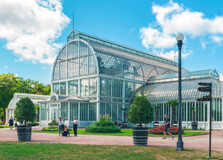
Slottsskogen Park is one of the most beloved green spaces in Gothenburg, Sweden. Known as the “green heart” of the city, this vast public park combines lush gardens, peaceful walking trails, a zoo with Nordic animals, historical monuments, and vibrant recreational areas. Whether you are a local looking for a serene escape or a tourist wanting to experience the essence of Gothenburg’s nature and culture, Slottsskogen Park is a must-visit destination. How to Reach Slottsskogen Park, Gothenburg Slottsskogen Park is conveniently located in the western part of central Gothenburg. You can reach it easily by: By Tram: Several tram lines stop near the park, including lines 1, 2, and 7. The nearest stops are “Linnéplatsen” and “Marklandsgatan.” By Bus: Many bus routes connect to the park area, making it accessible from different parts of Gothenburg. By Bicycle or On Foot: Gothenburg is bike-friendly, and the park is just a short ride or walk from downtown. By Car: There is limited parking available nearby, so public transport is often the easier choice. Weather at Slottsskogen Park Gothenburg experiences a temperate oceanic climate. Summers (June to August) are mild and pleasant, with average temperatures between 18°C and 23°C—perfect for outdoor activities in the park. Spring and autumn are cooler but equally beautiful, with colorful foliage and blossoming flowers. Winters (December to February) are cold, averaging around 0°C, and snow is occasional. Each season offers a unique charm, from summer picnics to cozy winter walks. Timings of Slottsskogen Park Slottsskogen Park is open to the public year-round and does not have an entrance gate, so visitors can enjoy it at any time of the day. However, specific attractions within the park, such as the zoo and cafés, operate on their own schedules, generally opening around 9:00 AM and closing by 5:00 PM. Why Famous for Slottsskogen Park, Gothenburg? The park is famous for its combination of natural beauty, recreational facilities, and cultural value. Its highlights include the Slottsskogen Zoo, which features Nordic animals like moose, seals, and penguins; the large playground that is a favorite among children; and the scenic walking paths surrounded by diverse flora. The park also hosts concerts, festivals, and events throughout the year, making it a lively spot for locals and tourists alike. Entry and Visit Details about Slottsskogen Park Entry to Slottsskogen Park is completely free. The zoo within the park is also free of charge, which makes it a popular family destination. Visitors can explore the park on foot, by bike, or even enjoy guided tours during special events. There are several cafés and food stalls offering refreshments, especially during the warmer months. History and Architecture of Slottsskogen Park Established in the late 19th century, Slottsskogen Park was designed to bring the beauty of the countryside into the city. It was inspired by English-style landscaped gardens, blending open lawns with wooded areas and carefully maintained flowerbeds. The park has evolved over the years, adding recreational facilities, monuments, and the zoo, but it has retained its historic charm and naturalistic design. Things to Do at Slottsskogen Park Visit the Slottsskogen Zoo to see moose, seals, penguins, and other Nordic wildlife. Explore the Botanical Gardens and enjoy seasonal flowers. Enjoy a picnic on the lush green lawns. Walk or cycle along the scenic trails within the park. Take children to the playground, one of the largest in Gothenburg. Attend concerts, cultural festivals, and outdoor events in the park. Spot historical monuments and statues scattered across the grounds. Facts about Slottsskogen Park The park covers around 137 hectares, making it one of the largest in Gothenburg. It has been open to the public since 1874. The zoo is one of the few free-entry animal parks in Sweden. Slottsskogen is a popular venue for the annual Way Out West music festival. There is a historical observatory located within the park. Tips for Visiting Slottsskogen Park Wear comfortable shoes, as the park is large and best explored on foot. Visit early in the morning or late in the afternoon for a peaceful experience. If traveling with children, set aside time for the playground and zoo. Bring snacks or enjoy the cafés inside the park. Check the Gothenburg event calendar to see if there are concerts or festivals during your visit. Spring and summer are the most vibrant times to visit, but autumn colors are also breathtaking.
Explore More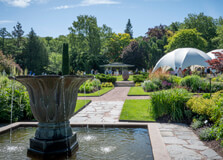
The Botanical Garden in Gothenburg (Göteborgs Botaniska Trädgård) is one of the largest and most beautiful botanical gardens in Europe. Spread across approximately 175 hectares, it combines cultivated garden areas with a nature reserve, offering an enchanting mix of landscaped gardens, greenhouses, and untouched woodland. The garden is home to around 16,000 plant species from all over the world, making it a paradise for nature lovers, photographers, and researchers alike. Its peaceful environment makes it a perfect escape from the city's bustle while still being close to central Gothenburg. How to Reach Botanical Garden, Gothenburg The Botanical Garden is located about 2 km from the city center of Gothenburg, making it easily accessible by public transport, bicycle, or even on foot. By Tram: Take tram number 1, 2, or 7 from central Gothenburg and get off at the “Botaniska Trädgården” stop, which is directly near the entrance. By Bus: Several bus routes stop nearby, including lines 25 and 52. By Car: The garden can be reached via Dag Hammarskjöldsleden road, with parking spaces available near the entrance. By Foot or Bicycle: The garden is connected to the city by pedestrian and cycle-friendly paths. Weather at Botanical Garden, Gothenburg Gothenburg has a temperate oceanic climate, influenced by its coastal location. The best visiting months are from late spring to early autumn when the flowers are in full bloom and the weather is mild. Spring (March–May): Mild temperatures between 8°C–15°C; early flowers bloom. Summer (June–August): Warm and pleasant, 18°C–25°C, ideal for garden walks. Autumn (September–November): Cool weather with colorful foliage. Winter (December–February): Cold, around 0°C–5°C; the greenhouse remains a warm refuge for visitors. Timings The outdoor garden is generally open daily from morning until evening, while the greenhouse has specific visiting hours. Typically: Outdoor Gardens: 09:00 AM – Sunset Greenhouses: 10:00 AM – 4:00 PM (closed on some holidays) It is advisable to check the official website before visiting for updated timings and seasonal events. Why Famous for Botanical Garden, Gothenburg? The Botanical Garden is renowned for its vast plant collection, including rare and endangered species. Highlights include the Japanese Valley, a lush Rhododendron valley, an impressive Rock Garden with alpine plants, and tropical greenhouses with exotic orchids and carnivorous plants. It is also famous for conservation efforts and plant research, making it a vital scientific institution in Sweden. Entry and Visit Details about Botanical Garden, Gothenburg The outdoor gardens are free to enter, but there is a small fee for visiting the greenhouses. Donations are encouraged to support garden maintenance and research. Outdoor Garden Entry: Free (donations welcome) Greenhouse Entry: Around 20–30 SEK Best Visiting Time: May to September for peak blooms; winter for greenhouse visits. History and Architecture of Botanical Garden, Gothenburg The Botanical Garden was inaugurated in 1923 as part of Gothenburg’s 300th anniversary celebrations. It was designed to blend scientific research with public recreation. The garden’s layout features themed sections, such as the herb garden, perennial borders, and the arboretum. Architecturally, the greenhouses are designed to replicate different climatic zones, allowing diverse plant life to thrive. Over the years, the garden has expanded to include a nature reserve that connects to Änggårdsbergen, offering hiking opportunities. Things to Do at Botanical Garden, Gothenburg Stroll through the Japanese Valley and enjoy its serene atmosphere. Explore the Rock Garden with its alpine and Mediterranean plants. Visit the tropical greenhouse for exotic orchids, ferns, and rare plants. Enjoy birdwatching in the nature reserve. Take part in guided tours and educational workshops. Relax at picnic spots and enjoy scenic views. Photograph seasonal blooms and landscapes. Facts about Botanical Garden, Gothenburg It covers over 175 hectares, including cultivated gardens and a nature reserve. Home to more than 16,000 plant species. The Rock Garden has won international awards for its design. The Japanese Valley is one of the most visited sections during spring. It is one of the largest botanical gardens in Northern Europe. Tips for Visiting Botanical Garden, Gothenburg Wear comfortable walking shoes, as the garden is large and involves a lot of walking. Carry a camera for capturing the stunning plant life and landscapes. Check for seasonal events like orchid exhibitions or guided tours. Visit early in the morning for a quieter experience. Bring a picnic if visiting during summer to enjoy the outdoor seating areas. Keep an eye on weather forecasts and dress accordingly.
Explore More